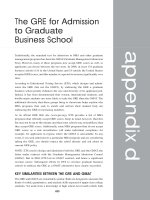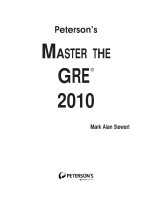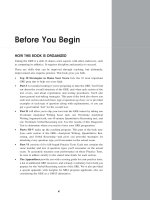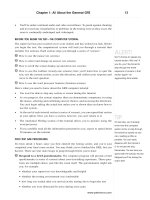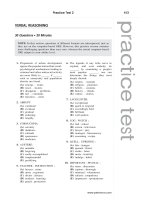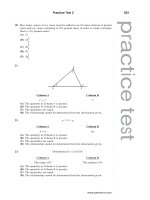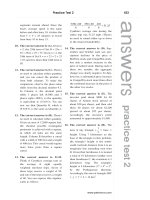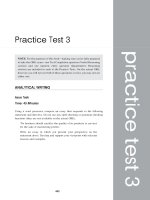Tài liệu Master the Gre 2010 - Part 2 pptx
Bạn đang xem bản rút gọn của tài liệu. Xem và tải ngay bản đầy đủ của tài liệu tại đây (40.6 KB, 10 trang )
Before You Begin
HOW THIS BOOK IS ORGANIZED
Taking the GRE is a skill. It shares some aspects with other endeavors, such
as competing in athletics. It requires discipline and practice to succeed.
These are skills that can be improved through coaching, but ultimately,
improvement also requires practice. This book gives you both.
• Top 10 Strategies to Raise Your Score lists the 10 most important
GRE prep tips to help you score high.
• Part I is essential reading if you’re preparing to take the GRE. You’ll find
out about the overall structure of the GRE, and what each section of the
test covers, and about registration and testing procedures. You’ll also
learn general test-taking strategies. This part of the book also shows you
each test section and each basic type of question up close; we’ve provided
examples of each type of question (along with explanations), so you can
get a good initial “feel” for the overall test.
• Part II will allow you to dip your toes into the GRE waters by taking one
45-minute Analytical Writing Issue task, one 30-minute Analytical
Writing Argument task, one 45-minute Quantitative Reasoning test, and
one 30-minute Verbal Reasoning test. Use the results of this Diagnostic
Test to determine where you need to focus your GRE preparation.
• Parts III–V make up the coaching program. This part of the book ana-
lyzes each section of the GRE—Analytical Writing, Quantitative Rea-
soning, and Verbal Reasoning—and gives you powerful strategies for
attacking every question type you’ll encounter in the actual exam.
• Part VI consists of five full-length Practice Tests. Each test contains the
same number and mix of question types you’ll encounter on the actual
exam. To accurately measure your performance on these Practice Tests,
be sure to adhere strictly to the stated time limits for each section.
• The Appendixes provide you with a scoring guide for your practice tests,
a list of additional GRE resources, and a handy vocabulary list to help you
prepare for the Verbal Reasoning section of the GRE. We’ve also provided
a special appendix with insights for MBA program applicants who are
considering the GRE as a GMAT alternative.
....................................................................................
xi
RECENT AND UPCOMING TEST CHANGES AND THIS BOOK
In 2007, ETS began implementing a variety of specific changes to the GRE. Some of
those changes are already being phased in—and they’re covered in this book. Note that
these changes are only for the computer-based GRE (the CBT). The changes do not
apply to the paper-based version of the test, which is offered only in certain remote
locations outside the United States and Canada, or to split administration in China
(including Hong Kong), Korea, or Taiwan.
New Format for Reading-Comprehension Passages
On the computer-based GRE, Reading Comprehension passages have been reformat-
ted. Previously, line numbers appeared to the left of each passage, and a question
referring to a specific passage part (e.g., a phrase or sentence) would provide a line
reference. Line numbers have been omitted; instead, the specific passage part is
highlighted (shaded) to help you locate it more easily.
New Question Types
On the computer-based GRE, a test taker may now encounter ONE question of ONE of
two new types:
Text Completion (Verbal Reasoning section). This question type involves a brief
passage of text containing 2–3 fill-in blanks, three choices per blank.
Numeric Entry (Quantitative Reasoning section). This is a type of Problem
Solving question in which the test taker enters a numeric response using the
keyboard, rather than selecting among multiple choices.
No test taker will encounter both question types or more than one question of either
type. Also, some test takers may not encounter either type.
Future Changes to the GRE
ETS plans to gradually increase the number of Text Completion and Numeric Entry
questions appearing on the General Test. Other likely revisions for the future include
reducing the number of Analogy and Antonym questions (or eliminating them entirely),
as well as adding Critical Reasoning questions based on paragraph-length arguments.
These and any other changes to the GRE are at least a year or two away, however, and
therefore are not reflected in this book’s current edition.
SPECIAL STUDY FEATURES
Peterson’s Master the GRE is designed to be as user friendly as it is complete. To this
end, it includes several features to make your preparation more efficient.
Overview
Each chapter begins with a bulleted overview listing the topics covered in the chapter.
This will allow you to quickly target the areas in which you are most interested.
Before You Beginxii
.................................................................
..............................................................................................
www.petersons.com
Summing It Up
Each chapter ends with a point-by-point summary that reviews the most important
items in the chapter. The summaries offer a convenient way to review key points.
Bonus Information
As you work your way through the book, keep your eyes on the margins to find bonus
information and advice. Information can be found in the following forms:
NOTE
Notes highlight need-to-know information about the GRE, whether it’s details about
registration and scoring or the structure of a question type.
TIP
Tips provide valuable strategies and insider information to help you score your best
on the GRE.
ALERT!
Alerts do just what they say—alert you to common pitfalls and misconceptions you
might face or hear regarding the GRE.
USING THIS BOOK TO PREPARE FOR THE
COMPUTER-BASED GRE
Here’s something to keep in mind as you work with this book: When taking the
computer-based version of the GRE, you’ll be entering answers by typing on a key-
board or using a mouse. Some parts of the exam, such as the Analytical Writing
section, require that you type sentences and paragraphs. Other sections require that
you select answer choices by clicking on them with your mouse. Obviously, answering
in this fashion isn’t possible in a printed book—you’ll have to fill in your answers by
hand when taking the tests we’ve provided here.
ABOUT THE CD
The CD accompanying this book gives you access to the latest computerized testing
software, which closely replicates the testing experience you will experience on the
actual GRE. The software was developed by Peterson’s, and the Practice Test content
was created by the test-prep experts at Peterson’s.
YOU’RE WELL ON YOUR WAY TO SUCCESS
You’ve made the decision to apply to graduate school and have taken a very important
step in that process. Peterson’s Master the GRE will help you score high on the exam
Before You Begin xiii
.................................................................
..............................................................................................
www.petersons.com
and prepare you for everything you’ll need to know on the day of your exam. Good
luck!
GIVE US YOUR FEEDBACK
Peterson’s publishes a full line of resources to help guide you through the graduate
school admission process. Peterson’s publications can be found at your local
bookstore, library, and college guidance office, and you can access us online at
www.petersons.com.
We welcome any comments or suggestions you may have about this publication and
invite you to complete our online survey at www.petersons.com/booksurvey. Or you
can fill out the survey at the back of this book, tear it out, and mail it to us at:
Publishing Department
Peterson’s, a Nelnet Company
2000 Lenox Drive
Lawrenceville, NJ 08648
Your feedback will help us make your educational dreams possible.
Before You Beginxiv
.................................................................
..............................................................................................
www.petersons.com
TOP 10 STRATEGIES TO RAISE YOUR SCORE
Regardless of the books, software, or other GRE-prep resources you’re using, certain
time-tested strategies for GRE preparation never go out of style. To attain your
optimal GRE scores and to maximize your chances of getting into your first-choice
graduate program, keep the following strategies in mind:
1. Don’t neglect your weaknesses. When preparing for the GRE, some test takers
make the mistake of focusing on their strengths, and they neglect to work on
eliminating their weaknesses. They tell themselves, “I can’t handle these tough
sections right now,” and they decide either to face them later or skip them
completely and take their chances on the actual exam. However, you can’t “hide”
your individual GRE scores from the admissions committees, and you don’t want
to be unprepared in any way. The best strategy here is to avoid spending more
time than you need on any one area of the GRE. Don’t waste time reviewing what
you already know. Instead, devote as much time as possible to improving areas
where you know you need extra practice.
2. Don’t neglect the two GRE essays. Among GRE test takers, it’s especially
common to neglect preparing for the essay section of the exam. Don’t make this
mistake! This is one area where it’s impossible to “guess” your way through the
test. What’s more, graduate schools are more frequently focusing on the GRE
essays to help them make tough decisions among applicants—many of whom
appear equally qualified otherwise. This means that your Analytical Writing score
could very well make the difference between your being accepted to your preferred
program and being rejected—especially at a school where you may be a “bor-
derline” candidate.
3. Practice under exam conditions. When it comes to GRE preparation, there’s
simply no substitute for putting yourself to the test by taking the Practice Tests in
this book under simulated testing conditions. Here are some suggestions:
• Adhere to the time limits that each exam section imposes. If possible, use a
word processor to compose your practice essays rather than writing them
out, and use only the features that will be available on the stripped-down
GRE word processor. Take at least one computer-based Practice Test.
• Don’t underestimate the role that endurance plays in taking the GRE. Half
the battle is making it through the half-day ordeal with your wits intact.
You can prepare for the long day of taking the exam by taking at least one
timed full-length Practice Test straight through, with only a few short
breaks.
4. Take the real GRE once—just for practice. If you have time and can afford to,
register for and take the real GRE once as a “dress rehearsal.” This can help you
.................................................................
............................................................................................
Before You Begin xv
www.petersons.com
